1.The Hashemite Federation (Iraqi-Jordanian) Union (Monarchist-Kingdom)
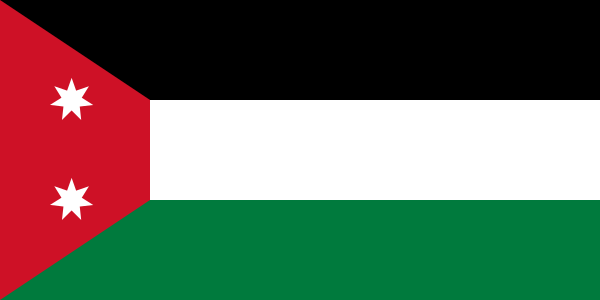
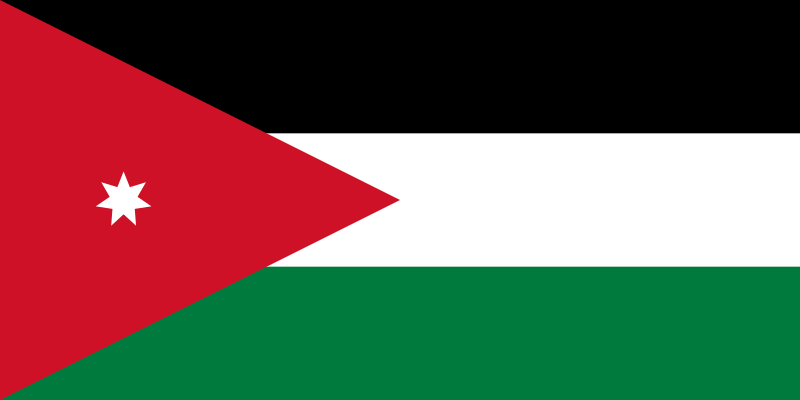
This federation was agreed upon on February 14, 1958 A.D., and is also known as the Arab Union. It is a non-fusion union that was officially announced on February 14, 1958 between the Hashemite Kingdom of Iraq and the Hashemite Kingdom of Jordan. The Federation’s constitution states that the federation consists of “the Hashemite Kingdom of Iraq and the Hashemite Kingdom of Jordan.
Its membership is open to every Arab country that wishes to join it in agreement with the Federation’s government, with each member state maintaining its independent international personality and the existing system of rulers in it. The constitution also states that the King of Iraq is The president of this union, and that the headquarters of the union’s government will be periodically six months in Baghdad and six months in Amman.
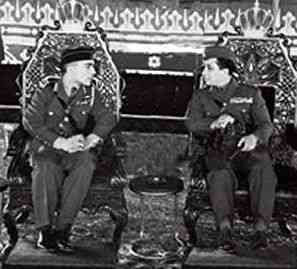
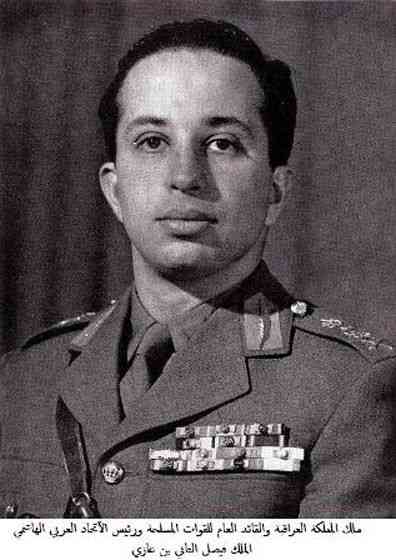
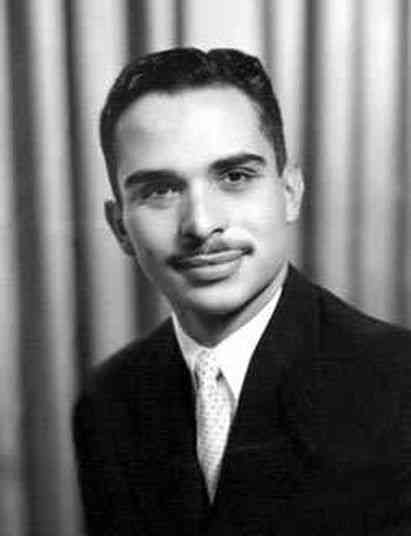

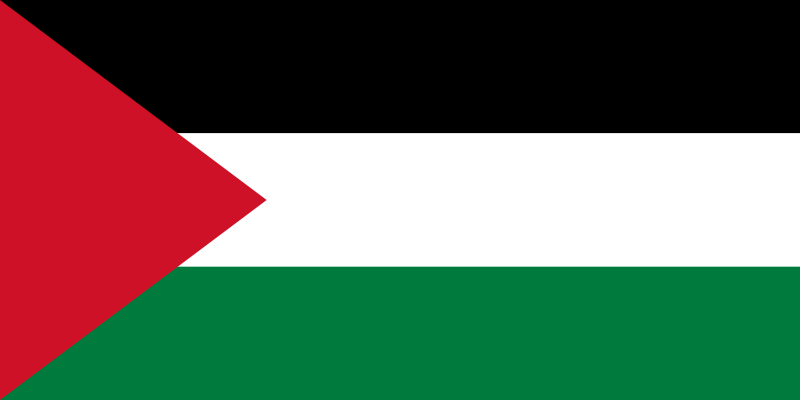
On February 17, 1958 AD, this agreement was ratified by the House of Representatives and the Iraqi and Jordanian representatives.
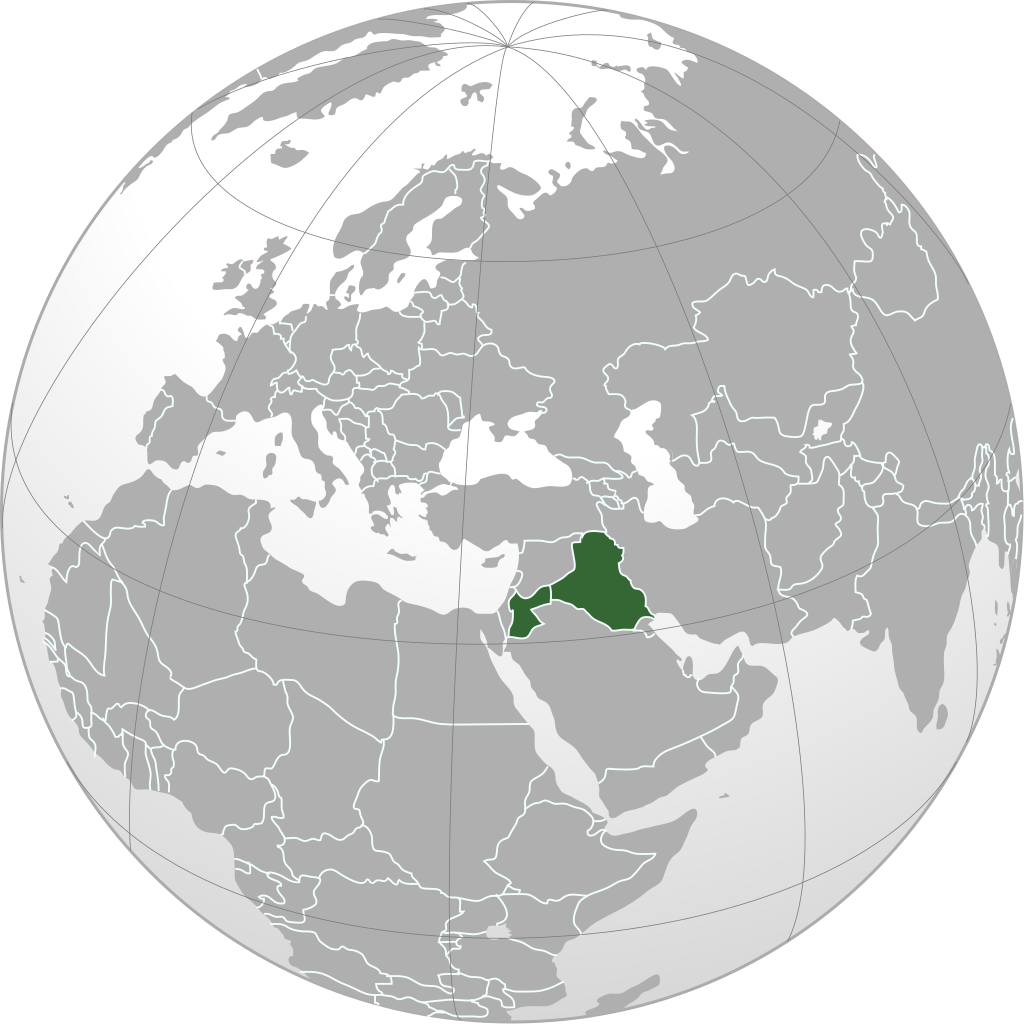
On May 19, 1958, the first ministerial government of the Federation was formed and its composition was as follows:
Nuri Al-Saeed (Iraqi) - Prime Minister.
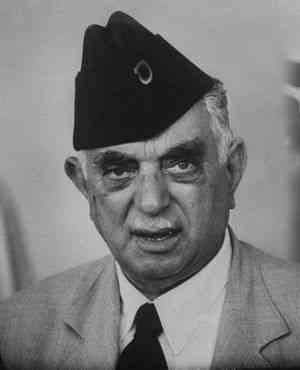
Ibrahim Hashem (Jordanian Prime Minister) - Deputy Prime Minister of the Federation.

Tawfiq Al-Suwaidi (Iraqi) - Minister of Foreign Affairs.
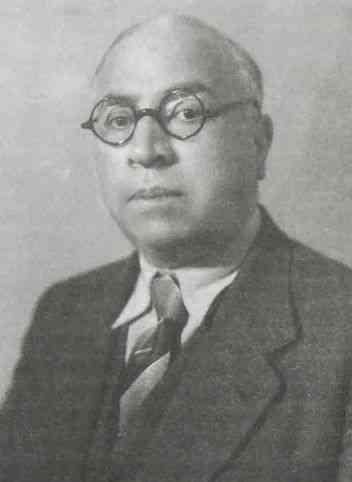
Khulusi al-Khairi (Jordanian) - Minister of State for Foreign Affairs.

Suleiman Touqan (Jordanian) - Minister of Defense.
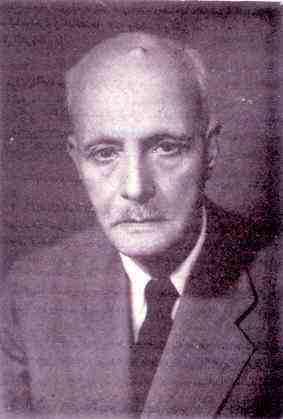
Sami Fattah (Iraqi) - Minister of State for Defense Affairs.
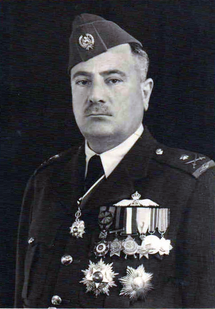
Abdul Karim Al-Azri (Iraqi) - Minister of Finance.
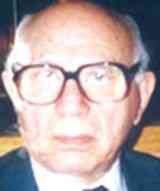
As for the strategy, the union came on the basis of the establishment of a unit called (the United Arab Republic) that was established between Egypt and Syria on February 1, 1958 AD, and was an ideological violation of the Jordanian and Iraqi kingdoms.
However, this unit was not sustainable, as it effectively ended on July 14, coinciding with the overthrow of the monarchy in Iraq, and Abdul Karim Qasim’s announcement of the new Prime Minister of Iraq on July 16, when the Hashemite Union dissolved, describing it as “not a true union targeting the interests of the people in The two countries, but rather to consolidate the corrupt monarchy and to tear the unity of the ranks of the liberal Arab, and to achieve the interests of a group of rulers did not come to rule through the people).
The late King Hussein had assumed the presidency of the Federation and the leadership of the armed forces on 14 July after the killing of the king's cousin, King Faisal, may God have mercy on him, but this was not effective in practice given the great strength in the Iraqi army, especially after the revolution.
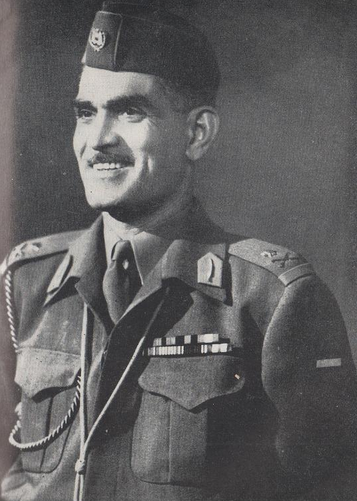
2.United Arab Republic ( Republic System )

The United Arab Republic was a sovereign state in the Middle East from 1958 to 1971. It started as a political union between Egypt (which includes the Gaza Strip under Egyptian administration) and Syria from 1958. In 1960 the two countries' parliament was unified in the National Assembly in Cairo and the regional ministries were abolished in favor A unified ministry in Cairo, too. Until Syria withdrew from the union after the Syrian coup of 1961, and a number of Syrian military personnel, driven by Western parties and backed by Saudi Arabia and Jordan, seceded. One of the reasons for the separation was that Gamal Abdel Nasser nationalized private banks, factories and major industrial companies, which were flourishing, such as spinning, weaving, cement, etc.)
These nationalizations have wronged the owners of these institutions who are upset with these decisions. Separation was followed by five coups in Syria over a period of 20 months. Egypt was known as the United Arab Republic until 1971. The United Arab Republic was under the leadership of Egyptian President Gamal Abdel Nasser. The United Arab Republic was a member of the United Arab States, a loose confederation with the Yemeni Mutawakkil Kingdom, which was dissolved in 1961.
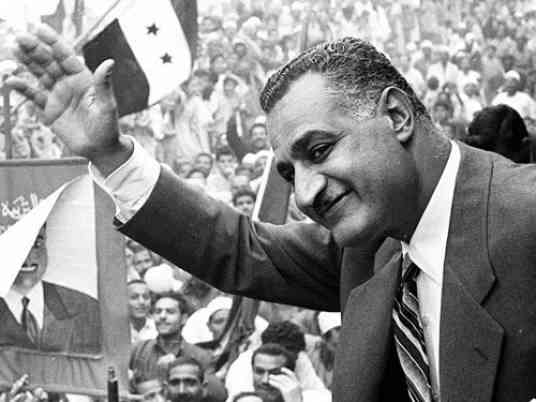
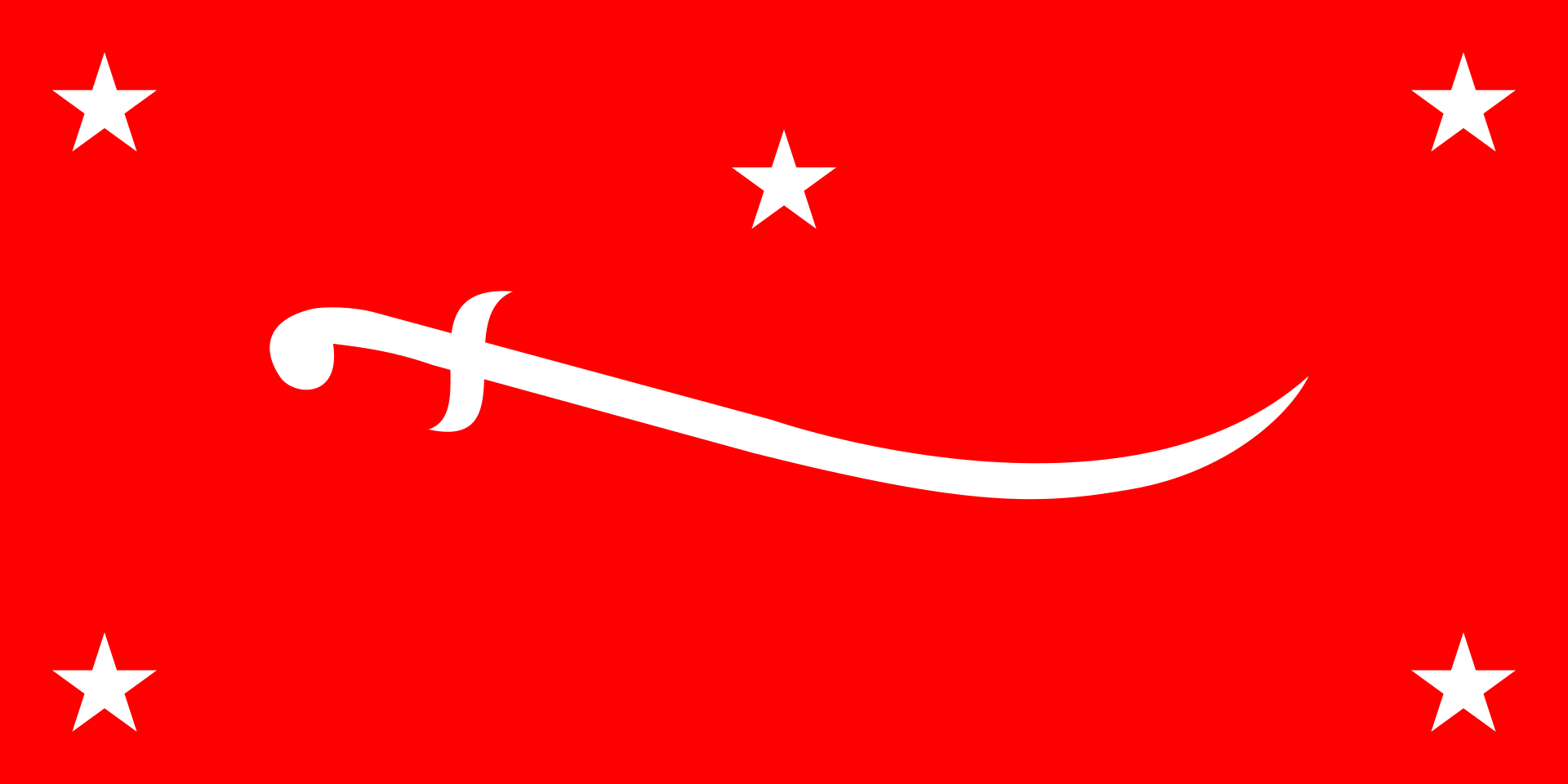
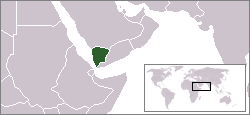
Some considered that the Egyptian-Syrian unity that was announced on February 22 of 1958, was the result of the permanent demand of a group of Syrian officers, at a time when the leaders of the Baath Arab Socialist Party had campaigned for union with Egypt. As journalist Patrick Seale sees, "... that Gamal Abdel Nasser was not enthusiastic about an organic unity with Syria, nor did he aspire to manage Syria's internal affairs and to inherit its problems.
Rather, he called for" Arab solidarity "by which the Arabs stood behind him against the great powers, and he was In particular, he needs to control Syria's foreign policy in order to mobilize his Western and Arab enemies. This was a completely different idea from the unitary Baath program of breaking borders. But he could not take anything and leave nothing, and thus the Syrians pushed him to agree to the establishment of the United Arab Republic.
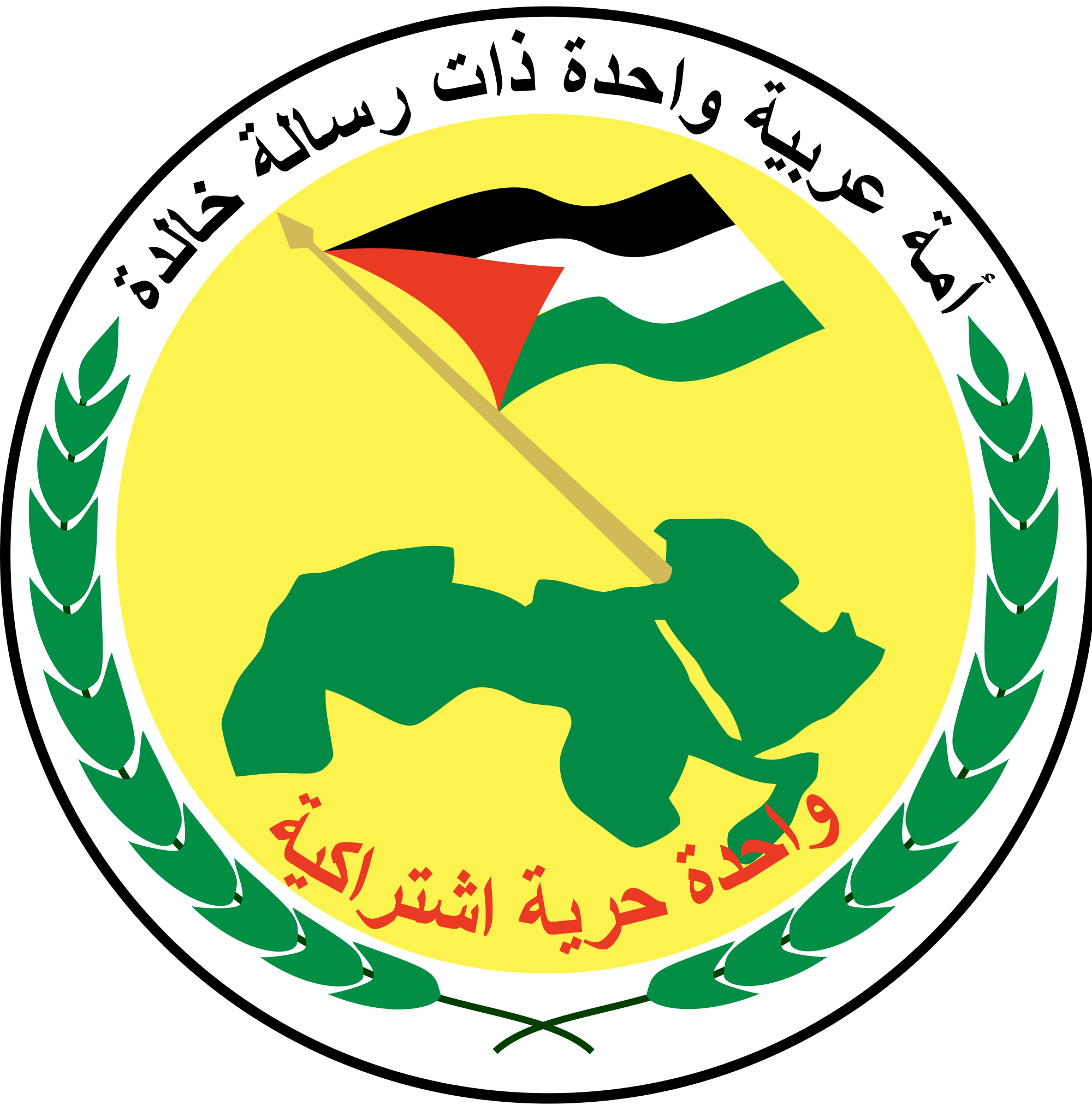
Dr. George Jabbour considered: "Since the middle of 1954, and especially since the beginning of 1955, the masses in Syria have shown a special interest in Egypt's revolution: the channel agreement, the resistance of the alliances, the crystallization of the Arab idea among the leaders of the Egyptian revolution, the Zionist pressure on Egypt represented in the campaign against Gaza In the beginning of 1955, the Bandung Conference, the arms deal, explains the social direction of the revolution and its serious fight against the feudalism ...
All this earned the revolution and its leader great respect in the progressive and democratic circles in the Syrian Arab country, so if we add to all of that weight that Egypt represents in the Arab world: Humanly, culturally, and especially geographically, it became clear to us that the polarization of the Nasserite leadership to the Arab masses in the second half of the fifties was inevitable.
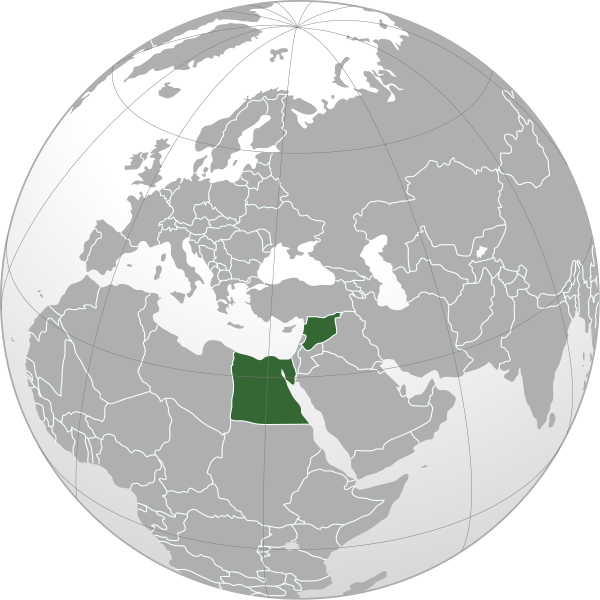
Jabour continued: "The features of this polarization began in Syria in 1955 when the revolution government in Egypt proposed confronting the Baghdad Pact, the slogan of adopting an independent Arab foreign policy, within the scope of the Arab League, and strengthening the Arab collective security pact. This slogan received the appreciation it deserves in the national powers in Syria drew a new government in which the Baath Party contributed to the government, and also began from that period inviting the Baath Party to unite between Egypt and Syria, as they are the most liberated countries from other Arab countries.
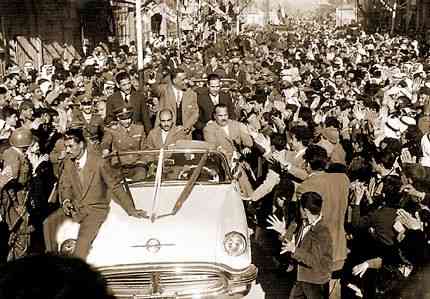
Historians see that during the political history of Syria, that with the election of Shukri Al-Quwatli in the year 1955, the situation was resolved in the interest of the stream calling for cooperation and alliance with Egypt. This rapprochement, as the Soviet Union began in the beginning of 1956, with a broad diplomatic campaign to acquire the countries of the Middle East, and Syria and Egypt in February of the same year accepted the Soviet arms deals at a time when the Baghdad Pact was threatening the Syrian territories with the support of Britain, countries from other Arab countries.
And Dr. Ahmed Serhal saw that when the Battle of Sinai erupted in October 1956 and the tripartite aggression against Egypt occurred, "The Syrian government declared a state of emergency in its territories and units of its forces headed to stationed in Jordan after they disrupted the pipeline transporting Iraqi oil to the Lebanese coast. These were forced Unity to withdraw from Jordan, starting on April 24, 1957, after American forces threatened to intervene against it. "
The Syrian government can no longer withdraw from its new policy, as it felt a degree of isolation in front of Iraqi and even Israeli politics. In October 1957, it concluded an economic cooperation treaty with the Soviet Union.
On October 18, 1957, the Syrian parliament and the Egyptian parliament met in a joint session and unanimously issued a statement inviting the governments of the two countries to meet and report on the union between the two countries. In this direction, the heads of state of the two countries met and the staffs of their governments issued a statement on February 22, 1958, in which they declared the unification of the two countries in one country in the United Arab Republic, which decided that its system would be a democratic presidential system.
Indeed, a popular referendum on unity took place and Gamal Abdel Nasser was elected President of the United Arab Republic. On March 5, 1958, a new temporary constitution was enacted for the United Arab Republic ... The constitution gave the executive authority to the President of the Republic, which he exercised effectively, with the assistance of the Deputy Prime Ministers who appointed and dismissed them, and they were accountable to him exclusively. Note that there were two regional executive councils besides the central government in the United Arab Republic: the Egyptian Executive Council, and the Syrian Executive Council, each headed by a central minister.
They are accountable to him and not others. Note that there were, alongside the central government in the United Arab Republic, two regional executive councils: the Egyptian Executive Council, and the Syrian Executive Council, each headed by a central minister. As for the legislative authority, it was assumed by a National Assembly composed of deputies, half of whom appointed the President of the Republic and the other half he chose from among members The former parliament in Syria and Egypt has granted the National Assembly the right to put confidence in the ministers, but only individually without the collective ministerial responsibility that remained standing before the President of the Republic only. Thus, the regime maintained its strict presidential nature, especially since some members of the council were appointed by the president, and this contravenes and transcends the nature of the presidential system that is initially based on the separation of powers.
Lawyer Ghalib Yaghi (who at that time took over the secretariat of the Qatari leadership of the Arab Socialist Baath Party in Lebanon), considered that Arab unity was and still is a dream for the Arabs, and the Egyptian-Syrian unity came in response to the desires of the Egyptian and Syrian people, within the framework of the pressing international atmosphere, and events Witnessed by the Arab world from the nationalization of the Suez Canal, and the tripartite aggression against Egypt, And the Turkish crowds on the Syrian borders, to the plots and intrigues of the Baghdad alliance ... And since the days of the establishment of the government of Sabri Al-Asali in Syria, Michel Aflaq insisted that the ministerial statement of the government include a call for Syrian-Egyptian unity, and this call met with the support of the Syrian People’s Assembly.
A number of brigade commanders in the Syrian army negotiated with the Egyptian government about unity, among them were Abdel-Ghani Qanout, Amin al-Hafiz, Salah Jadid and Mustafa Hamdoun. The unit was announced, and the Syrian President, Shukri Al-Quwatli, was granted the title of "the first Arab citizen".
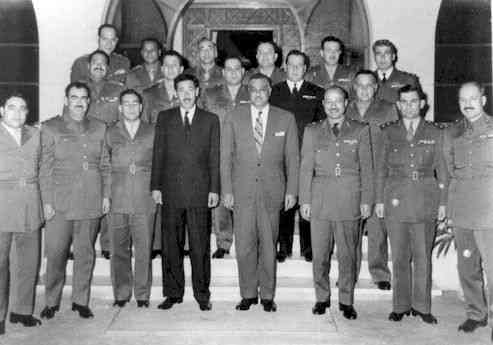
Nasser announces unity :-
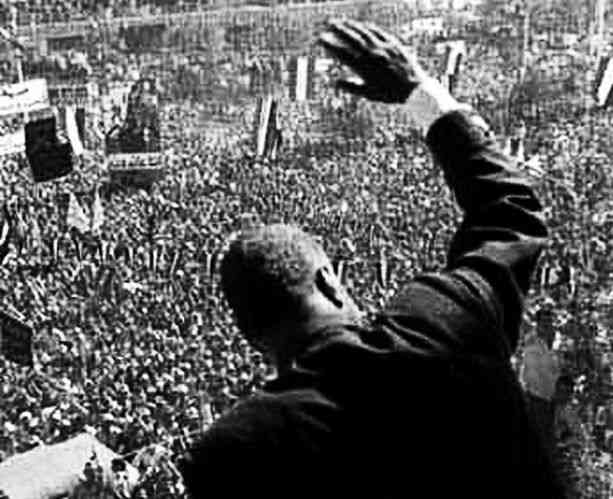
The establishment of the United Arab Republic.February 24, 1958 :-
Dear citizens :-
Peace and mercy of God..
I feel now, and I am among you the happiest moment of my life, as I have always looked at Damascus, to you, and Syria, and I look forward to the day I meet you, and today, today, I visit Syria, the beating heart of Arabism .. Syria, which always carried the banner of Arab nationalism .. Syria, which has always been calling With Arab nationalism ... Syria, which has always interacted with a deep heart, with Arabs everywhere.
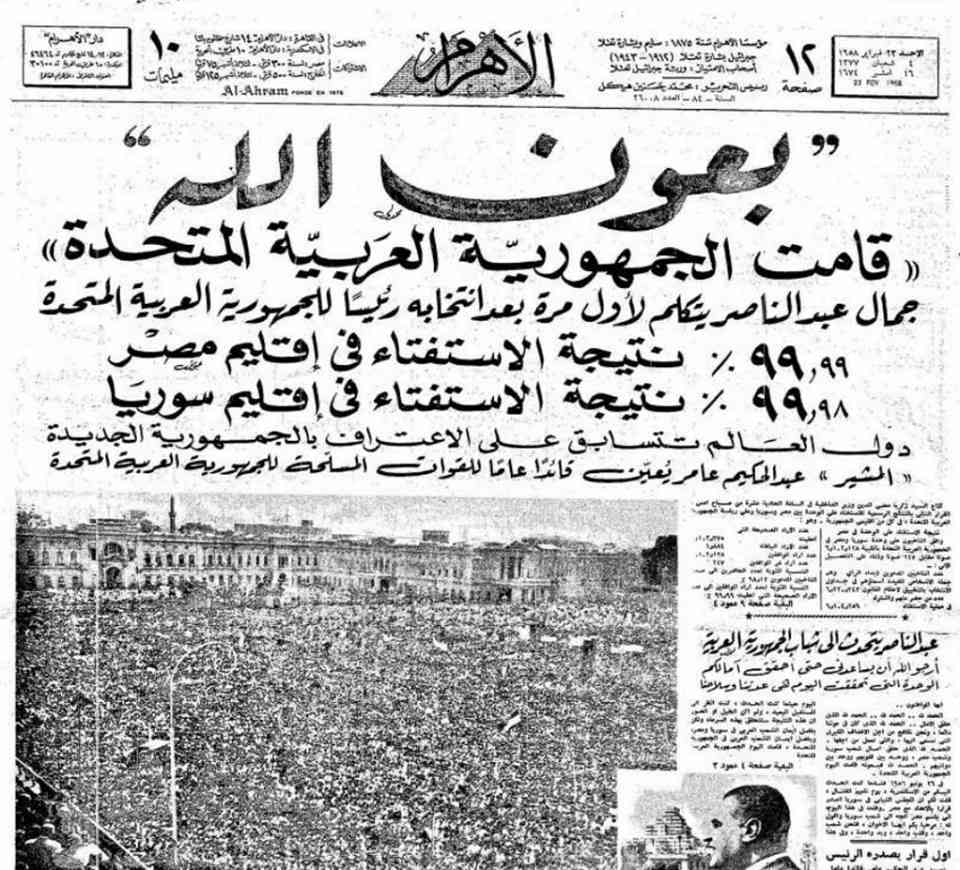
Today - fellow citizens - God has achieved this hope and this anticipation, and I meet with you on this eternal day, after the United Arab Republic is fulfilled.
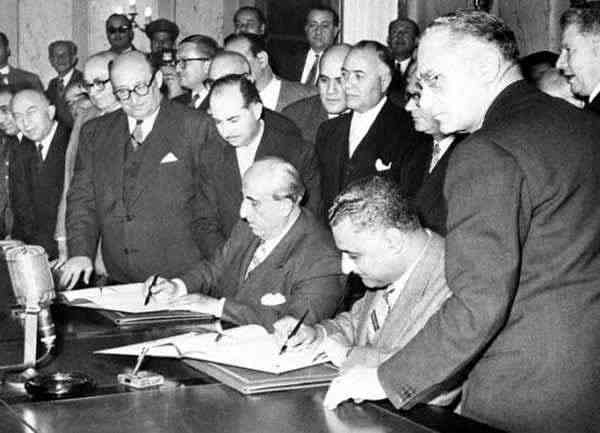
Nationalization :-
Nasser delivers a speech at the crowds in Damascus, 1960.In June 1960, Nasser attempted to implement economic reforms that would make the Syrian economy more consistent with the strong Egyptian public sector. However, these changes have done little to help the two economies. Instead of shifting growth towards the private sector, Abdel Nasser has made unprecedented nationalization waves in Egypt and Syria. Nationalization operations began in July 1961, without consulting the Syrian SEO. The government seized the cotton trade, as well as all export and import companies.
On July 23, 1961, Nasser announced the nationalization of banks, insurance companies, and all heavy industries. Nasser also extended his principles of social justice. The area of land allowed to be reduced has been reduced from 200 to 100 acres. The interest rate for farmers decreased dramatically until it was abolished in some cases. A tax of ninety percent is imposed on all income brackets, which exceed 10,000 pounds. Workers and employee representatives were allowed on the boards of directors. They were also granted the right to a 25% stake in their company’s profits. The average working day was also reduced from eight hours to seven without a reduction in wages.
Collapse :-
Nasser and al-Sarraj in Lattakia, 1959. On June 9, 1958, the Syrian Customs Authority imposed fees on some Egyptian products, which necessitated the intervention of President Gamal Abdel Nasser for what he considered a challenge to the central authority in the United Arab Republic. Abdel Nasser summoned his two Syrian representatives, Akram Al-Hourani and Sabri Al-Asali, to Cairo, and the central cabinet issued a decision stating that economic policy in the two regions of the republic should be drawn up by the central government and not the executive councils in the two regions.
On November 11, 1958, the President of the United Arab Republic, Jamal Abdel Nasser, issued a decision to form state security courts in the northern region (Syria), to which crimes against the orders of the military governor are issued in the event of an emergency. The decision provided for the formation of primitive state security courts in each governorate and supreme state security courts in Damascus and Aleppo.
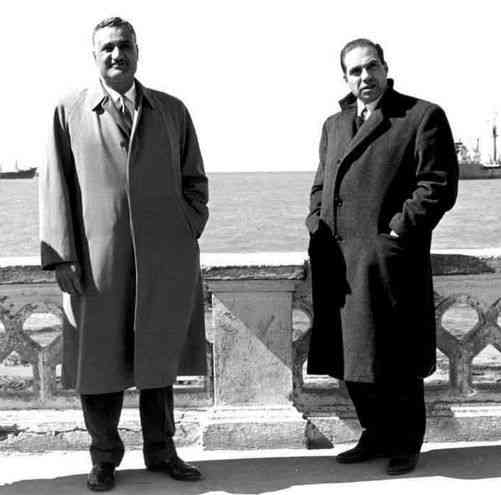
On December 30, 1959: The resignation of the Baathist ministers from the Central Government of the United Arab Republic and the Executive Council of the Northern Territory: Akram Al-Hourani, Vice President and Minister of Justice in the Central Government, Salah Al-Bitar, Minister of Culture and National Guidance in the Central Government, Mustafa Hamdoun, Minister of Agrarian Reform, Abdul Ghani Qunoot, Minister Social Affairs and Labor in the Executive Council. And after the escalation of differences between the Baath and Abdul Hakim Amer. After 4 days, Economy Minister Khalil Al Kallas, who is also a Baathist, was relieved of his post in the Executive Council.
The charged political atmosphere had its first role in secession, in addition to Arab and foreign interventions. Representative Sami Al-Khatib does not deny that "the internal reasons have played their role in securing the separation, in addition to the role played by the western embassies that were since the foundation against this unit.
And Sami Sharaf considered that there were internal issues affecting the conditions and mechanisms of governance in both Syria and Egypt that provided grounds for the success of the separatists. "there were foreign fingers playing to break this unity out of fear of the unitary scope that would have had an effect in the entire Arab region, and would lead to changes in it, and prevent Israel from achieving its expansionist goals."
Sharaf mentions several reasons that led to the separation and the collapse of the unit, including:
1.The lack of a geographical connection between Syria and Egypt, which makes the control of the central government limited.
2. Keeping the army away from interfering in politics, which is a thorny and complicated issue in Syria in particular, as Syrian officers have been interfering in politics for the medulla, since 1949.
3. The one political organization, the National Union, which was applied in Egypt was not acceptable to the Syrian Baath Party specifically ... The results of the National Union elections in Syria were considered a defeat for the Baathists and a victory for Abdul Hamid al-Sarraj.
4. It was difficult to complete the unification of laws between Egypt and Syria, especially those that govern the movement of people and trade and the removal of barriers between the two regions.
5. Talking about the displacement of one million Egyptian farmers to the Gezira region.
6. Domination of the Syrian army with Egyptian officers.
On September 28, 1961, a group of Syrian officers led by Lt. Col. Abdul Karim al-Nahlawi (director of the office of Abd al-Hakim Amer), with Jordanian-Saudi support, and with the support of Syrian businessmen disaffected by the nationalization decisions, launched a (military coup) in a crisis atmosphere in all respects. President Nasser was surprised by the news of the Syrian rebellion, and he ordered the dispatch of a force of two thousand Egyptian paratroopers to Syria to crush this rebellion. However, the positions of the army leaders in Lattakia in support of the rebels prompted Nasser to revoke his orders, knowing that the Egyptian vanguard of 120 paratroopers had announced surrender after their landing.
Abdel-Hakim Amer had left Damascus around three in the afternoon on the day of the coup d'etat to Cairo, and Salah al-Bitar and Akram al-Hourani had supported the separation and were among the Syrian politicians who signed the separatist document on October 2, 1961.
On October 10, 1961: the United States formally recognized the secession government in Syria, 12 days after the military coup that toppled unity with Egypt.
On October 27, 1961: a Syrian commando blew up a secret radio in support of Egypt and opposed to the secession government, broadcasting from inside Lebanese territory near the border village of Helwa. Syrian sources revealed the raid ten days after it was carried out, and mentioned the killing of three and the arrest of seven, one of whom is Egyptian, and the rest are Lebanese and Palestinians.
After the withdrawal of Syria :-
It seems that the remorse came upon the Damascus officers, and after a few months, they realized the enormity of what they made and found that the democracy they preached established a "separatist" state that sits in its parliament and governments, the right-wing people of the bourgeois, feudal, tribal, and fundamentalist brothers.
At a rare moment in the awakening of conscience, the revolutionaries embarked on the night wing, so they deposited the President of the Republic, Nazem Al-Qudsi, the terrible Mazza Prison and went to Cairo crying in front of Jamal Abdel Nasser, demanding the return of unity, and putting themselves at his disposal to do whatever he wanted. Abdel Nasser rejected them and told them that "the unity that went with a coup does not return with a coup.
Pro-unity military attempts :-
Al-Nahlawi, together with a number of his companions, left Syria to exile forcibly, and by his departure, the era of the most dangerous real separation began in Syria, which on March 8, 1963 replaced his men with other men, led by Michel Aflaq, Salah al-Bitar, Amin al-Hafiz, Salah al-Jadid, and their most dangerous and fiercest was Salim Hatoum and Abdel-Karim al-Jundi in particular.
Abdel Nasser's first attempts to eliminate separation :-
According to Abdel Karim El-Nahlawi, in a 2001 dialogue , Abdel Nasser has already attempted to eliminate separation and has already made numerous attempts. He heard from Ali Sabri, the former Egyptian Prime Minister, before his death a very interesting talk in which he said that Nasser was serious in resisting the separation militarily After it occurred on September 28, 1961 under Nahlawi's leadership, he did not send military airborne forces from Egypt to Latakia except on this basis.
The seven Egyptian warplanes had taken off from their bases in the Egyptian territories towards the Syrian airspace, as the ambassador of the Soviet Union in Egypt rushed to the phone with Abdel Nasser and informed him of an urgent oral message from the Kremlin saying to the late President, leave Syria alone. This was the hidden reason that prompted Nasser to order the return of the remaining flocks of aircraft to their bases in Egypt, and commanded the squadron commander Jalal Haridi to surrender himself and his paratroopers to the Syrians without resistance.
The second attempt :-
Then the second operation was on July 18, 1963, when Colonel Jassim Alwan secretly infiltrated from Syria to Lebanon and Lebanon, he made a secret visit to Egypt, during which he met Jamal Abdel Nasser, putting in his hands a plan for a military coup in Syria, but he confirmed that its success rate does not exceed 30%, however, Gamal Abdel Nasser asked him to implement it. Abdel Nasser intended to announce the unity of Egypt and Syria again in the speech of the Revolution Day on July 23, 1963.
If it succeeds, but in case of failure, he will announce his withdrawal from the tripartite unity agreement that he signed with both Iraq and Syria after Abdel Nasser realized that the Baath Party in both Syria and Iraq is trying to gain more time to exclude the Nasserites in both countries from any leadership positions. Indeed, that operation failed and Abdel Nasser announced his withdrawal from the unit and sent hundreds of Nasserists, in the Mezze prison in Damascus.
The third attempt The third attempt was on 7/27/1964 when Abdel Nasser asked the Syrian officer, Gado Ezz El-Din, to prepare for a military operation inside Syria from the Iraqi territories, and that process consisted of three stages:
- The first operation targets the eastern region of the Syrian territories (Deir Ezzor and the Al-Jazeera region in addition to the northern region of Aleppo and its dependencies).
- The second operation targets Damascus directly.
- The third operation targets the central region (Palmyra, Hama, Homs and their dependencies).
This planning was put in place on the assumption that the status of the Syrian Air Force at that time does not qualify it to deal successfully with the air force designated to cover the attack, but Nasser suddenly summoned Jadu Izz al-Din to inform him that he had dismissed that process and no one knew the secrets of that operation until after twenty-five years had passed A year from her hypothetical date, as narrated by the documents, Jadu Ezz El-Din, when it was reported that Major General Fouad Shehab, President of the Lebanese Republic at that time sympathetic to Nasser, conveyed to him information that the news of this operation was leaked to the United States, and that the latter is a trap for the Egyptian army similar to what happened to him in the Yemen war and based on Abdel Nasser has canceled that process.
Geography :-
Egypt
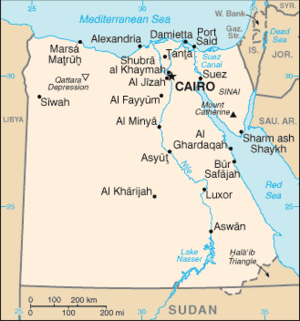
Syria
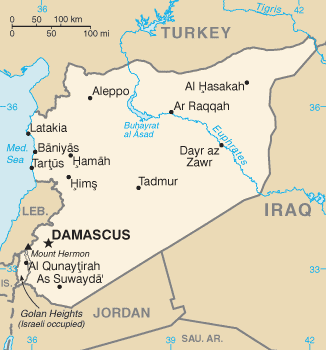
Gaza strip
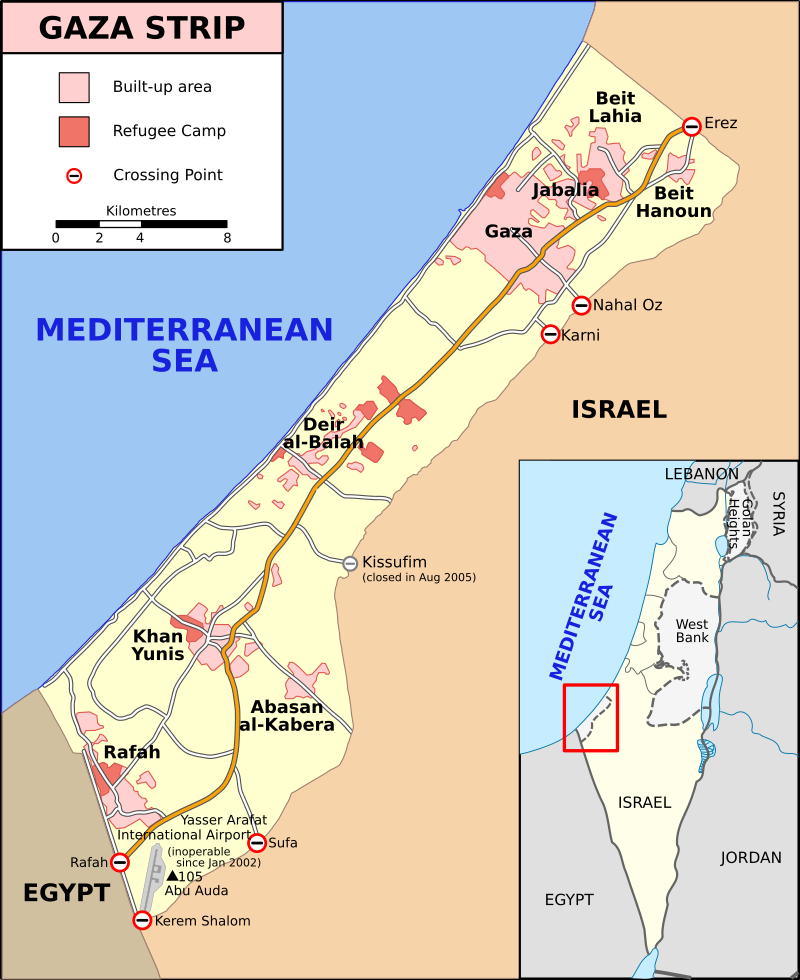
If it were ranked today, it would be the 25th largest Arab republic on the planet (Egypt ranked 30th and Syria ranked 88th). It was similar in size to South Africa, twice as large as France. After the dissolution of the All-Palestine government, the United Arab Republic exercised more control over the Gaza Strip, until the 1967 war.
Supporters :-
Sami Sharaf (Minister of State and Secretary of President Gamal Abdel Nasser) said: "... that unity with Syria has succeeded in achieving the stability that it has not been blessed with since the beginning of its modern history after the First World War, and provided it with all the ingredients to fulfill its Arab role ...
In the shadow of unity, Syria was able to achieve profound social changes that it had been aspiring to since independence, and to stop the Syrian feudalism against it, since the July 1961 laws were to fulfill long-standing demands that no political party could achieve ... and this experience proved that Arab unity is real, And that its foundations are correct, and embodied the dream of the Arab nation and the Arab revolution. "
In a meeting with Representative Sami Al-Khatib, who lived through that period as a security officer in the second branch (Lebanese Intelligence), he considered that "the Egyptian-Syrian unity was a result of the aspirations of the Arab peoples and their aspirations for autism, and they were part of our dreams and aspirations."
In the opinion of Ghaleb Yaghi, the unity between Egypt and Syria "gave hope to the Arab citizen that it is possible to seek comprehensive unity, and during that period was the decisive response to the conspiracies that were targeting Syria, Egypt, Lebanon and the rest of the Arab countries ...".
Against ( Not Supporters ) :-
On the other hand, opponents of the unity project and those who followed this historical period asserted that since the establishment of the United Arab Republic, "dictatorship" practices began on the part of President Abdel Nasser, who deliberately uprooted the thrust of Syrian politics, and he had set two conditions for the establishment of this unit, the first of which was that officers abstained On the practice of political work, and the dissolution of the parties in Syria, including the Baath Party, and this has caused a curse for a large number of Baathists who did not expect to exclude them from the unity and are among their makers.
In the opinion of Patrick Seale, the leaders of the Baath Party expected to become the ideological teachers of the United Arab Republic, to provide Nasser with an integrated faith, and to teach Arabism to Egypt itself. But all of that was nothing but dreams. Instead of the party-ready life that existed in Syria, Nasser created a structure that was at the same time authoritarian, ruthless, and disingenuous. All decisions were taken by him in Cairo, where he was employed by a small group of officers and security men. In Damascus, his dependence on a steadfast security man was Colonel Abdel Hamid Al-Sarraj, who raised him and made him Minister of the Interior.
The policy adopted towards Syria lost its control over its internal and external affairs, and political life in it was lacking, confined to the hands of Egyptian officials, and Damascus was no longer a conservative center, and Abdel Nasser established a central government that included: Akram al-Hourani, Salah al-Din al-Bitar, and Egyptian and Syrian affairs were within the competence of Two local executive boards. In November 1959, President Gamal Abdel Nasser sent his most prominent aide, Field Marshal Abdel Hakim Amer, to take over the rule of Syria, which he called the northern region. As for Egypt, it was the southern region.
And because the unity did not come according to what the Syrians wished, a number of them began to express its rejection and feelings, especially because of Egyptian interference in the stray and the incoming, and because of the marginalization of the role of Syrian leaders and leaders, even those who were in government positions, including Akram al-Hourani, who expressed his disappointment. Al-Hourani left Cairo after shaking his hands, returning to Hama, in the midst of complete disappointment with the experience of unity with Egypt ...
As Patrick Seale stated, “Hourani had personal reasons behind his bitterness, given that his political situation was damaged under Nasser, and before the unit he was the ruler maker in Syria, he was strong in the army, loved by the peasants ... Then Abd Al-Nasser extracted all of this and gave him in return an empty formal position in the government of the United Arab Republic, until he threw this position with disgust.
Attorney Ghaleb Yaghi indicated that Akram Al-Hourani told him in Beirut that the difference between him and Abdel Nasser was his main reason, the issue of converting the Israelis to the Jordan River, and this prompted him to submit his resignation from the position of the Presidency and from the Ministry of Justice in the central government, and Al-Hourani issued a statement on June 13 1963 After Syria's secession from Egypt, he spoke about what happened in the central ministry session in Cairo on November 29, 1959 (Al-Hourani mentioned this in his memoirs issued by the Madbouly Library in Cairo in 2000).
Those who lived through that period recall how the process of striking the Communist opponents began in the first place, after which the Baathists prolonged, and Lt. Col. Abdul Hamid al-Sarraj played the role of executioner.
Ghassan Zakaria (Adeel Abdel Hamid Al-Sarraj) saw: "... that the Sarraj transformed Syria in his time into a large prison, in which all aspects of democracy and its formalities disappeared, and beaten and tortured ministers, deputies, doctors, lawyers, journalists, businessmen, engineers, women and religious men, which he did not dare French colonialism for a quarter of a century for its action occupying the Levant and Lebanon with a hundred thousand soldiers.
Thank You For Reading The Article, I Hope You Enjoyed, Subscribe To Our Author's Page,,, Thank you.


